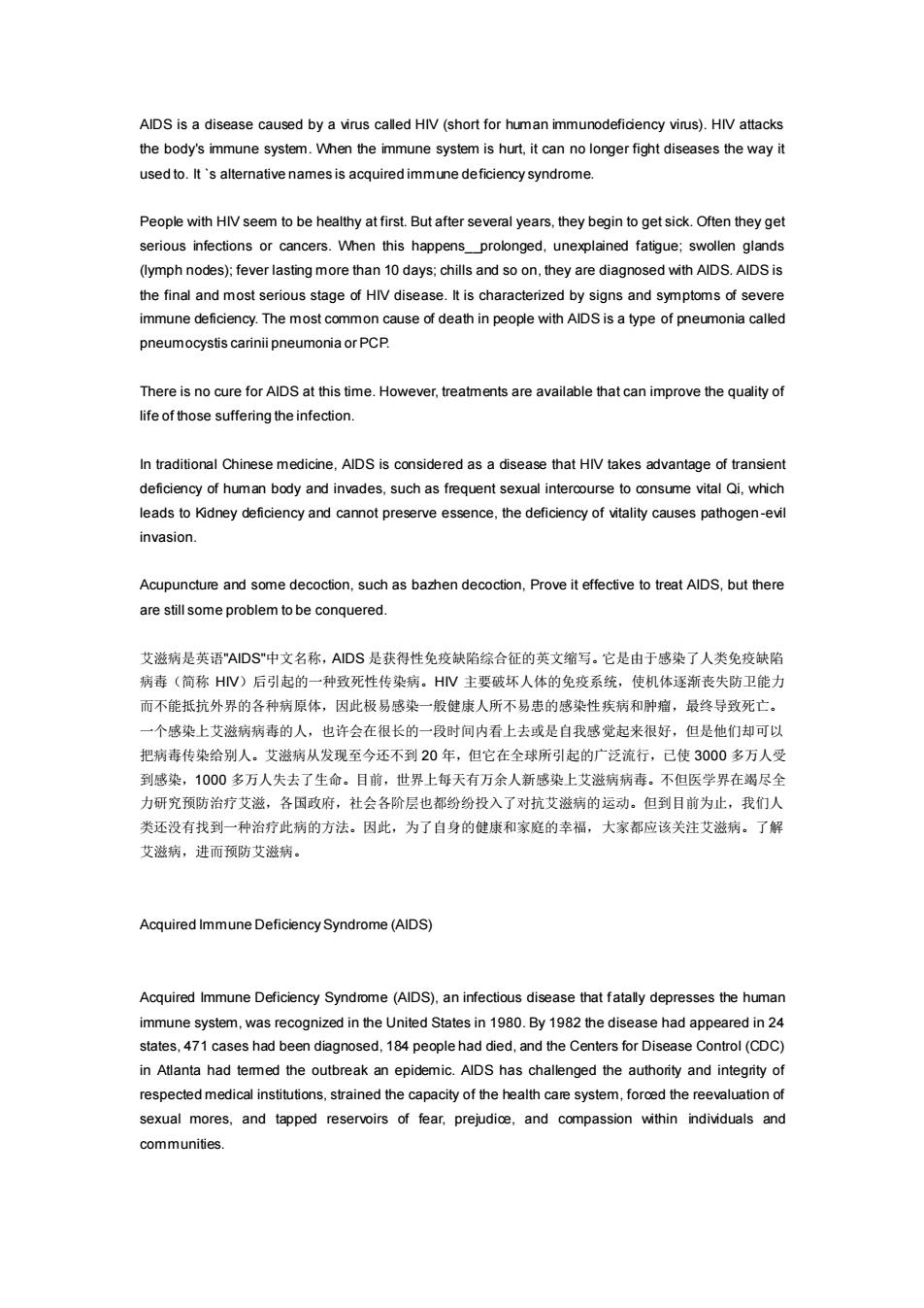
AIDS is a disease caused by a Mrus called HIV(short for human immunodefidency vinus).HIV attacks the body's immune system.When the immune system is hurt it diseases the way it People with HIV seem to be healthy at first But after several years.they begin to get sick.Often they ge serious infections or cancers.When this happens prolonged.unexplained fatque:swollen glands (lymph noe):fever asting moredays:chills andthey areagsed thDADs the final and stage f HIV disease scharacterized symptoms sever mmune deficiency.The most common cause of death in people with AlDS is a type of pneumonia calle pneumocystis carinii pneumonia or PCP There is no cure for alds at this time.However.treatments are available that can improve the quality of In traditional Chinese medicine.AIDS is considered as a disease that HIV takes advantage of transient deficiency of human body and invades.such as frequent sexual interoourse to consume vital Qi.which leads to Kdney deficiency and cannot preserve essence.the deficiency of vitality causes pathogen-evil invasion. Acupuncture and some decocion,such as bazhen decoction.Prove it effective to treat AIDS,but there are still some problem to be conquered. 艾溢实是英语“ADS中文名称,ADS是获得性免疫缺哈综合征的英文缩写,它是由于成染了人类免玻缺路 一个感染上艾滋病病毒的人,也许会在很长的一段时间内看上去或是自我感觉起米很好,但是他们却可以 把病毒传染给别人。艾滋病从发现至今还不到20年,但它在全球所引起的广泛流行,已使3000多万人受 到感染。1000多万人失去了生命,目前,世界上每天有万余人新感染上艾溢病病毒。不但医学界在竭尽全 力研究预防治疗艾溢,各国政府,社会各阶层也都纷纷投入了对抗艾病的运动。但到目前为止,我们人 类还没有找到一种治疗此病的方法。因此,为了自身的健康和家庭的幸福。大家都应该关注艾滋病。了解 艾溢病,进而预防艾滋病。 Acquired mmune Deficiency Syndrome(AIDS) Acquired Immune Deficiency Syndrome (AIDS).an infectious disease that fatally depresses the human immune system,was recognized in the United States in 1980.By 1982 the disease had appeared in 24 states,471cases had been diagnosed,184 people had died,and the Centers for Disease Control (CDC) in Allanta had temed the outbreak an epidemic.AIDS has challenged the authorty and integrity of respected medical instituions.strained the capacity of the health care system.forced the reevaluationo sexual mores.and tapped reservoirs of fear,prejudice,and compassion within individuals and communities
AIDS is a disease caused by a virus called HIV (short for human immunodeficiency virus). HIV attacks the body's immune system. When the immune system is hurt, it can no longer fight diseases the way it used to. It `s alternative names is acquired immune deficiency syndrome. People with HIV seem to be healthy at first. But after several years, they begin to get sick. Often they get serious infections or cancers. When this happens_prolonged, unexplained fatigue; swollen glands (lymph nodes); fever lasting more than 10 days; chills and so on, they are diagnosed with AIDS. AIDS is the final and most serious stage of HIV disease. It is characterized by signs and symptoms of severe immune deficiency. The most common cause of death in people with AIDS is a type of pneumonia called pneumocystis carinii pneumonia or PCP. There is no cure for AIDS at this time. However, treatments are available that can improve the quality of life of those suffering the infection. In traditional Chinese medicine, AIDS is considered as a disease that HIV takes advantage of transient deficiency of human body and invades, such as frequent sexual intercourse to consume vital Qi, which leads to Kidney deficiency and cannot preserve essence, the deficiency of vitality causes pathogen -evil invasion. Acupuncture and some decoction, such as bazhen decoction, Prove it effective to treat AIDS, but there are still some problem to be conquered. 艾滋病是英语"AIDS"中文名称,AIDS 是获得性免疫缺陷综合征的英文缩写。它是由于感染了人类免疫缺陷 病毒(简称 HIV)后引起的一种致死性传染病。HIV 主要破坏人体的免疫系统,使机体逐渐丧失防卫能力 而不能抵抗外界的各种病原体,因此极易感染一般健康人所不易患的感染性疾病和肿瘤,最终导致死亡。 一个感染上艾滋病病毒的人,也许会在很长的一段时间内看上去或是自我感觉起来很好,但是他们却可以 把病毒传染给别人。艾滋病从发现至今还不到 20 年,但它在全球所引起的广泛流行,已使 3000 多万人受 到感染,1000 多万人失去了生命。目前,世界上每天有万余人新感染上艾滋病病毒。不但医学界在竭尽全 力研究预防治疗艾滋,各国政府,社会各阶层也都纷纷投入了对抗艾滋病的运动。但到目前为止,我们人 类还没有找到一种治疗此病的方法。因此,为了自身的健康和家庭的幸福,大家都应该关注艾滋病。了解 艾滋病,进而预防艾滋病。 Acquired Immune Deficiency Syndrome (AIDS) Acquired Immune Deficiency Syndrome (AIDS), an infectious disease that f atally depresses the human immune system, was recognized in the United States in 1980. By 1982 the disease had appeared in 24 states, 471 cases had been diagnosed, 184 people had died, and the Centers for Disease Control (CDC) in Atlanta had termed the outbreak an epidemic. AIDS has challenged the authority and integrity of respected medical institutions, strained the capacity of the health care system, forced the reevaluation of sexual mores, and tapped reservoirs of fear, prejudice, and compassion within individuals and communities
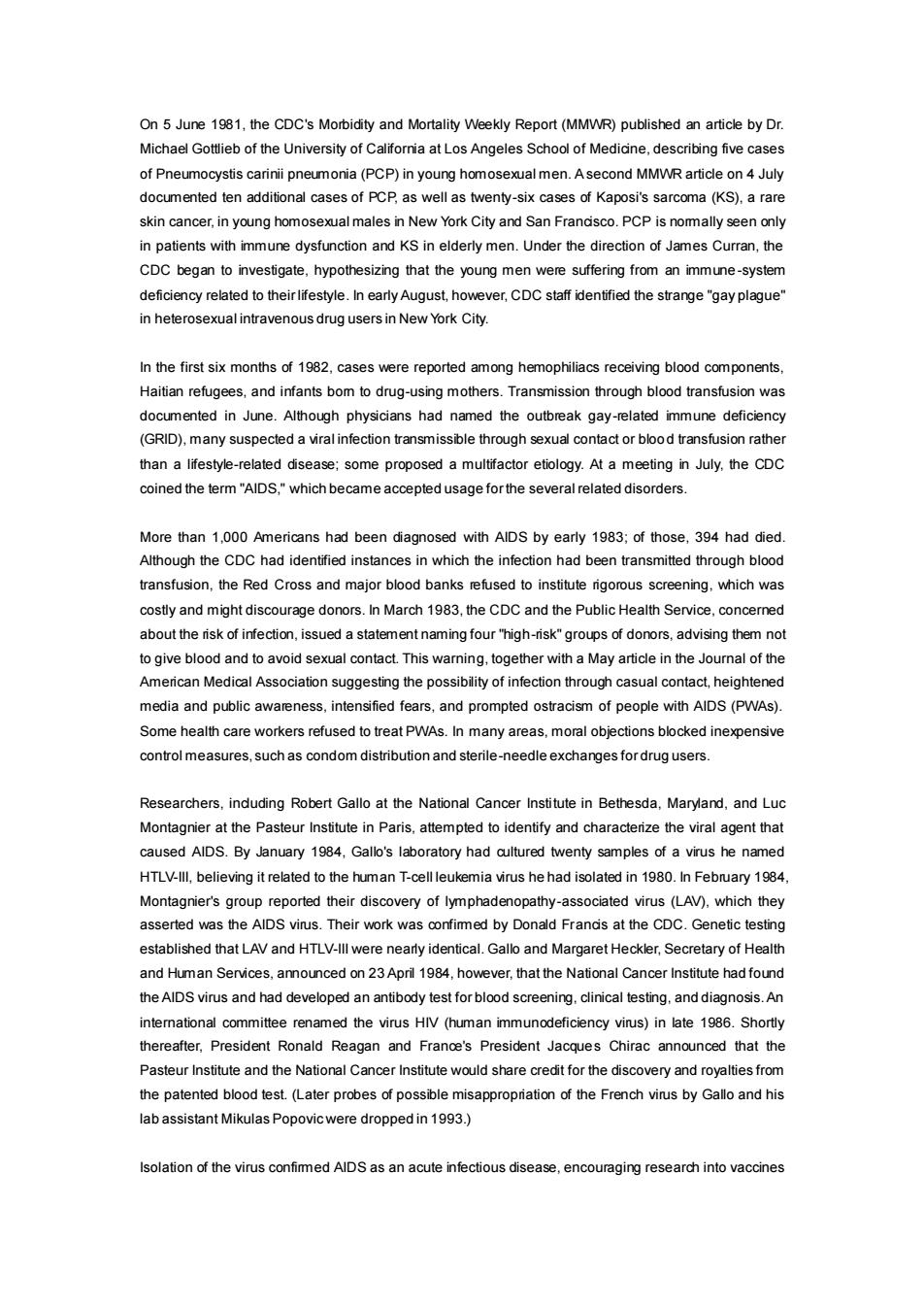
On 5 June 1981.the CDC's Morbidity and Mortality Weekly Report (MMWR)published an article by Dr. Michael Gottlieb of the University of California at Los Angeles School of Medicne.describing five cases of Pneumocystis carini pneumonia(PCP)in young MMWR documented ten additonal cases of PCP,as well as twenty-six cases of Kaposi's sarcoma (KS),a rare skin cancer,in young homosexual males in New York City and San Frandisco.PCP is nomally seen only in patients with immune dysfunction and KS in elderly men.Under the direction of James Curran.the CDC began to investigate.hypothesizing that the young men were suffering from an immune-system in heterosex intravenous drug users in New York City In the first six months of 1982.cases were reported among hemophiliacs receiving blood components Haitian refugees,and infants bom to drug-using mothers.Transmission through blood transfusion was inu phyhadaed eoubgayad han a lifestyle-related disease;some proposed a multifactor etiology.At a meeting in July.the CD( coined the term"AIDS,"which became accepted usage for the several related disorders. More than 1.000 Americans had been dagnosed with AlDs by early 1983:of those.394 had died hnneg2repboeaasamagooaaghna ad bee tran costly and might discourage donors.In March 1983.the CDC and the Public Health Service.concerned about the risk of infection,issued a statement naming four "high-risk"groups of donors,advising them not o give blood and to avoid sexual contact.This wamning.together with a May article in the Joumal of the ngthe of infecion through casual contact,heighte media and public awareness.fears.and of people with AIDS(PWAs Some health care workers refused to treat PWAs.In many areas,moral objections blocked inexpensive control measures.such as condom distribution and sterile-needle exchanges fordrug users. Researchers.induding Robert Gallo at the National Cancer institute in Bethesda.Marand.and Luc Montagnier at the p caused AIDS.By anuary 1984.Gallo's laboratory had oultured twenty samples of a virus he named HTLV-III,believing it related to the human T-cell leukemia virus he had isolated in 1980.In February 1984 Montagnier's group reported their discovery of lymphadenopathy-associated virus(LAV).which they asserted was the AIDS virus.Their work was confimed by Donald Frandis at the CDC.Genetic testing established that LAV and HTLV-ll we identical.alloand Margaret Hecker Secretary of Health and Human Services,amounced on,however,that the National Cancer Institute had four the AlDS virus and had developed an antibody test for blood screening.clinical testing.and diagnosis.Ar interational committee renamed the virus HiV (human immunodeficiency virus)in late 1986.Shortly thereafter,President Ronald Reagan and France's President Jacques Chirac announced that the Pasteur Institute and the National Cance d royalies from the lab assistant Mikulas Popovic were dropped in 1993. Isolation of the virus confimmed AlDS as an acute infectious disease,encouraging research into vaccines
On 5 June 1981, the CDC's Morbidity and Mortality Weekly Report (MMWR) published an article by Dr. Michael Gottlieb of the University of California at Los Angeles School of Medicine, describing five cases of Pneumocystis carinii pneumonia (PCP) in young homosexual men. A second MMWR article on 4 July documented ten additional cases of PCP, as well as twenty-six cases of Kaposi's sarcoma (KS), a rare skin cancer, in young homosexual males in New York City and San Francisco. PCP is normally seen only in patients with immune dysfunction and KS in elderly men. Under the direction of James Curran, the CDC began to investigate, hypothesizing that the young men were suffering from an immune-system deficiency related to their lifestyle. In early August, however, CDC staff identified the strange "gay plague" in heterosexual intravenous drug users in New York City. In the first six months of 1982, cases were reported among hemophiliacs receiving blood components, Haitian refugees, and infants born to drug-using mothers. Transmission through blood transfusion was documented in June. Although physicians had named the outbreak gay-related immune deficiency (GRID), many suspected a viral infection transmissible through sexual contact or blood transfusion rather than a lifestyle-related disease; some proposed a multifactor etiology. At a meeting in July, the CDC coined the term "AIDS," which became accepted usage for the several related disorders. More than 1,000 Americans had been diagnosed with AIDS by early 1983; of those, 394 had died. Although the CDC had identified instances in which the infection had been transmitted through blood transfusion, the Red Cross and major blood banks refused to institute rigorous screening, which was costly and might discourage donors. In March 1983, the CDC and the Public Health Service, concerned about the risk of infection, issued a statement naming four "high-risk" groups of donors, advising them not to give blood and to avoid sexual contact. This warning, together with a May article in the Journal of the American Medical Association suggesting the possibility of infection through casual contact, heightened media and public awareness, intensified fears, and prompted ostracism of people with AIDS (PWAs). Some health care workers refused to treat PWAs. In many areas, moral objections blocked inexpensive control measures, such as condom distribution and sterile-needle exchanges for drug users. Researchers, including Robert Gallo at the National Cancer Institute in Bethesda, Maryland, and Luc Montagnier at the Pasteur Institute in Paris, attempted to identify and characterize the viral agent that caused AIDS. By January 1984, Gallo's laboratory had cultured twenty samples of a virus he named HTLV-III, believing it related to the human T-cell leukemia virus he had isolated in 1980. In February 1984, Montagnier's group reported their discovery of lymphadenopathy-associated virus (LAV), which they asserted was the AIDS virus. Their work was confirmed by Donald Francis at the CDC. Genetic testing established that LAV and HTLV-III were nearly identical. Gallo and Margaret Heckler, Secretary of Health and Human Services, announced on 23 April 1984, however, that the National Cancer Institute had found the AIDS virus and had developed an antibody test for blood screening, clinical testing, and diagnosis. An international committee renamed the virus HIV (human immunodeficiency virus) in late 1986. Shortly thereafter, President Ronald Reagan and France's President Jacques Chirac announced that the Pasteur Institute and the National Cancer Institute would share credit for the discovery and royalties from the patented blood test. (Later probes of possible misappropriation of the French virus by Gallo and his lab assistant Mikulas Popovic were dropped in 1993.) Isolation of the virus confirmed AIDS as an acute infectious disease, encouraging research into vaccines
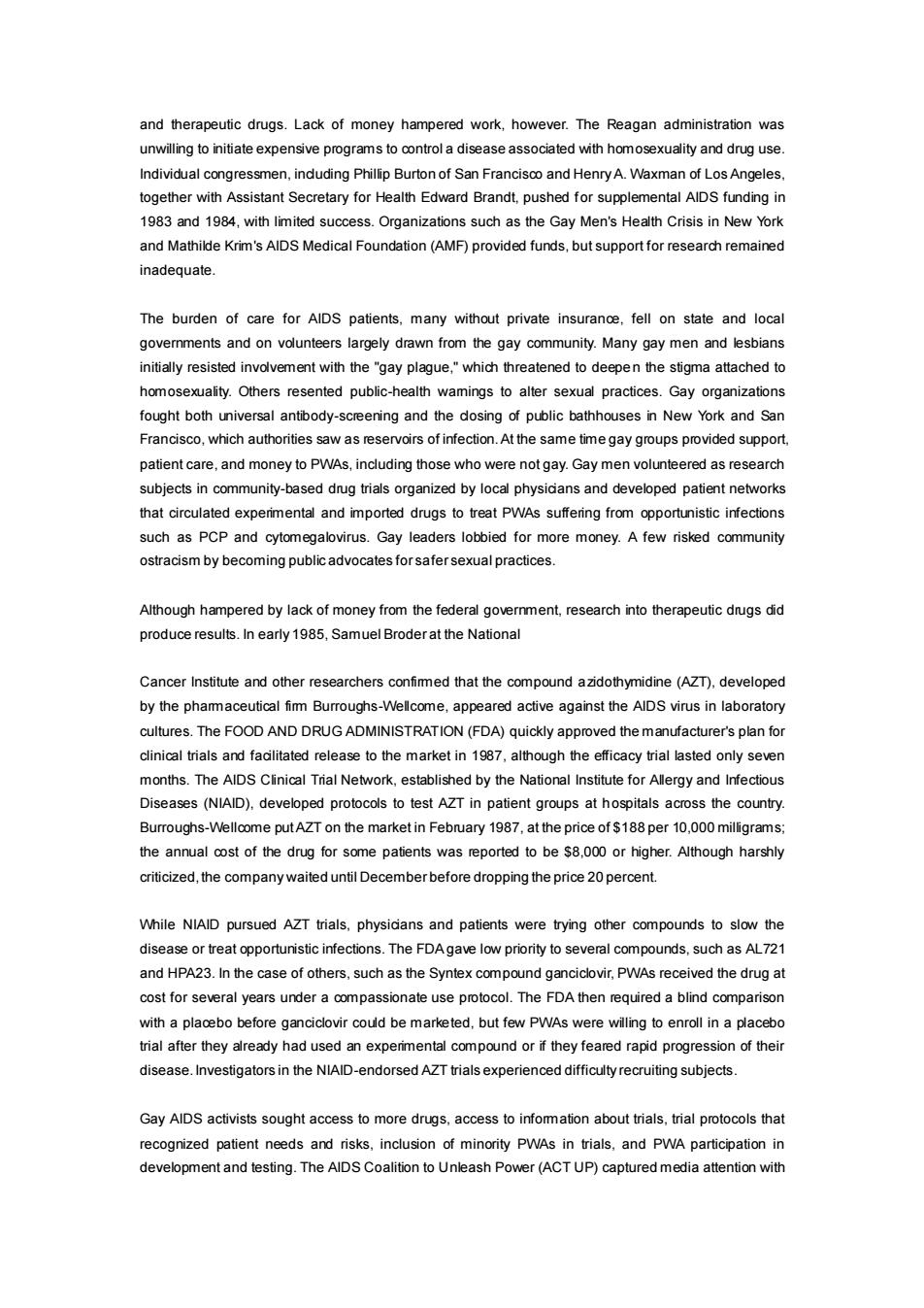
and therapeutic drugs.Lack of money hampered work,however.The Reagan administration was exuality and drug use ndMaualcangresne .induding Burtonof San Francisoo and HenryA W n of Los Angele ogether with Assistant Secretary for Health Edward Brandt,pushed for supplemental AlDS funding ir 1983 and 1984,with limited success.Organizations such as the Gay Men's Health Crisis in New York and Mathilde Krim's AlDS Medical Foundation (AMF)provided funds,but support for research remained inadequate. The burden of care for AIDS patients.many without private insurance.fell on state and loca governments and on vounteers largely drawn from the gay community.Many gay men and lesbians initially resisted invdlvement with thegay plaque"which threatened to deepen the stigma attached to homosexuality.Others resented public-health wamings to alter sexual practices.Gay organizations ought both sal antibody-s patient care,and money to PWAs.including those who were not gay.Gay men volunteered as research subjects in community-based drug trials organized by local physidans and developed patient networks that circulated experimental and imported drugs to treat PWAs suffering from opportunistic infections such as PCP and cyto egalovirus.Gay leaders lobbied for more money.A few risked community ostracism by be ng public cates forsafer sexual practices Although hampered by lack of money from the federal government research into therapeutic drugs did produce results.In early 1985,Samuel Broder at the National Cancer Institute and othe that the compound azidothymidine(AZT).developed by the phamaceutical fim Burroughs-Wellcome.appeared active against the AIDS virus in laboratory cultures.The FOOD AND DRUG ADMINISTRATION(FDA)quickly approved the manufacturer's plan for cinical trials and facilitated release to the market in 1987,although the efficacy trial lasted only seven months.The AIDS Cinical Trial Network.established by the National Institute for Alergy and Infectious atient groups at hospitals Bumoughs-Wellome marketin February1987.at the 10.000milligram he annual cost of the drug for some patients was reported to be S8.000 or higher.Although harshly criticized,the company waited until December before dropping the price 20 percent. While NIAID pursued AZT trials,physidans and patients were trying other compounds to com pounds,such as AL72 and HPA23.n te caseof ohers,such asthe Syntexcompound gancicovir,PWAs received cost for several years under a compassionate use protocol.The FDA then required a blind comparison with a placebo before ganciclovir could be marketed,but few PWAs were willing to enroll in a placebo trial after they already had used an expermental compound or if they feared rapid progression of their disease.Inve rin the NIAID-endorsedAZT rials experienced subiects Gay AlDS activists sought access to more drugs,access to infommation about trials,trial protocols that recognized patient needs and risks,inclusion of minority PWAs in trials,and PWA participation in development and testing.The AIDS Coalition to Unleash Power (ACT UP)captured media attention with
and therapeutic drugs. Lack of money hampered work, however. The Reagan administration was unwilling to initiate expensive programs to control a disease associated with homosexuality and drug use. Individual congressmen, including Phillip Burton of San Francisco and Henry A. Waxman of Los Angeles, together with Assistant Secretary for Health Edward Brandt, pushed f or supplemental AIDS funding in 1983 and 1984, with limited success. Organizations such as the Gay Men's Health Crisis in New York and Mathilde Krim's AIDS Medical Foundation (AMF) provided funds, but support for research remained inadequate. The burden of care for AIDS patients, many without private insurance, fell on state and local governments and on volunteers largely drawn from the gay community. Many gay men and lesbians initially resisted involvement with the "gay plague," which threatened to deepen the stigma attached to homosexuality. Others resented public-health warnings to alter sexual practices. Gay organizations fought both universal antibody-screening and the closing of public bathhouses in New York and San Francisco, which authorities saw as reservoirs of infection. At the same time gay groups provided support, patient care, and money to PWAs, including those who were not gay. Gay men volunteered as research subjects in community-based drug trials organized by local physicians and developed patient networks that circulated experimental and imported drugs to treat PWAs suffering from opportunistic infections such as PCP and cytomegalovirus. Gay leaders lobbied for more money. A few risked community ostracism by becoming public advocates for safer sexual practices. Although hampered by lack of money from the federal government, research into therapeutic drugs did produce results. In early 1985, Samuel Broder at the National Cancer Institute and other researchers confirmed that the compound azidothymidine (AZT), developed by the pharmaceutical firm Burroughs-Wellcome, appeared active against the AIDS virus in laboratory cultures. The FOOD AND DRUG ADMINISTRATION (FDA) quickly approved the manufacturer's plan for clinical trials and facilitated release to the market in 1987, although the efficacy trial lasted only seven months. The AIDS Clinical Trial Network, established by the National Institute for Allergy and Infectious Diseases (NIAID), developed protocols to test AZT in patient groups at hospitals across the country. Burroughs-Wellcome put AZT on the market in February 1987, at the price of $188 per 10,000 milligrams; the annual cost of the drug for some patients was reported to be $8,000 or higher. Although harshly criticized, the company waited until December before dropping the price 20 percent. While NIAID pursued AZT trials, physicians and patients were trying other compounds to slow the disease or treat opportunistic infections. The FDA gave low priority to several compounds, such as AL721 and HPA23. In the case of others, such as the Syntex compound ganciclovir, PWAs received the drug at cost for several years under a compassionate use protocol. The FDA then required a blind comparison with a placebo before ganciclovir could be marketed, but few PWAs were willing to enroll in a placebo trial after they already had used an experimental compound or if they feared rapid progression of their disease. Investigators in the NIAID-endorsed AZT trials experienced difficulty recruiting subjects. Gay AIDS activists sought access to more drugs, access to information about trials, trial protocols that recognized patient needs and risks, inclusion of minority PWAs in trials, and PWA participation in development and testing. The AIDS Coalition to Unleash Power (ACT UP) captured media attention with
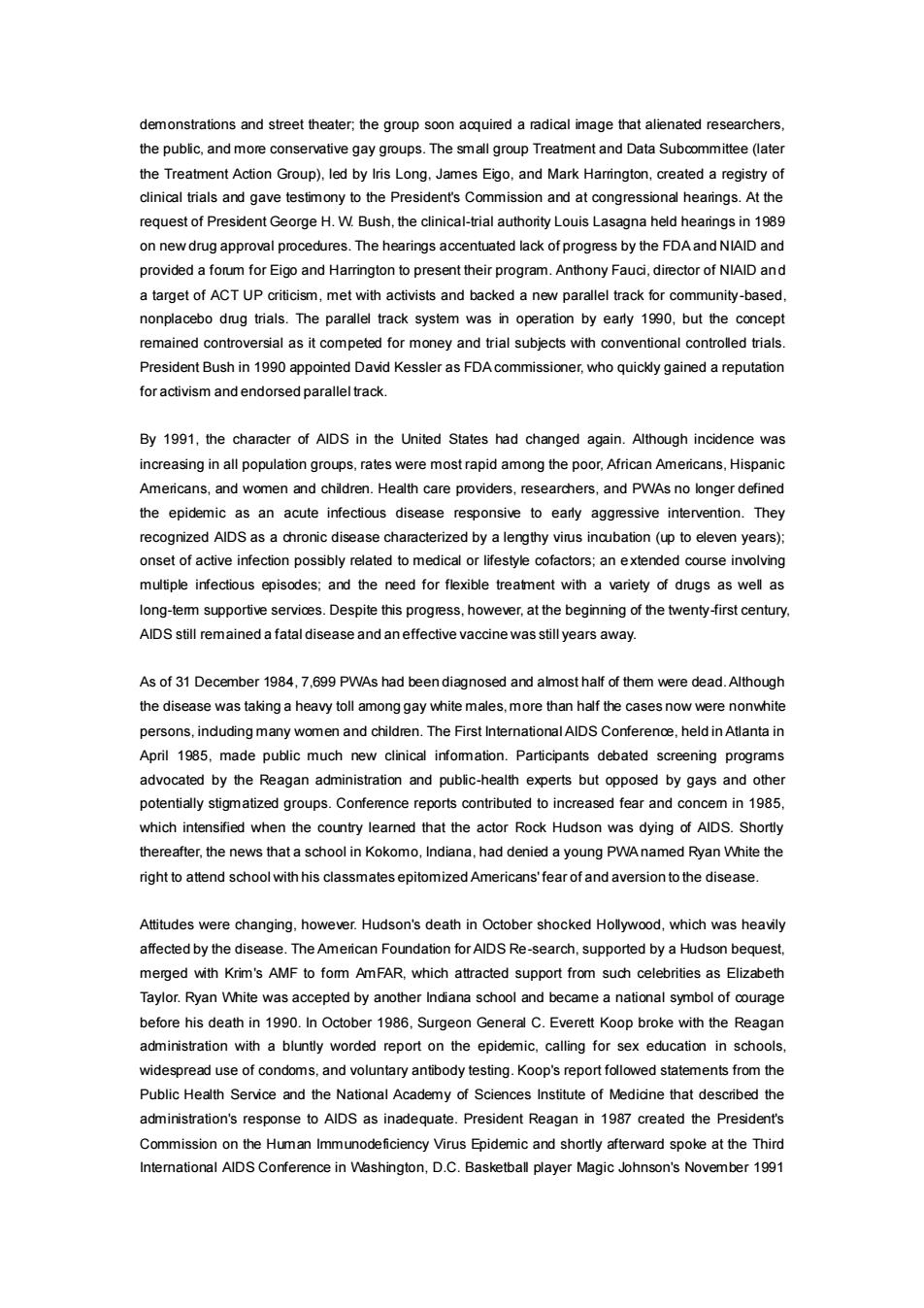
demonstrations and street theater,the group soon acquired a radical image that alienated researchers. the public,and more conservative gay groups.The small group Treatment and Data Subcommittee(later heTeamentActionCroupl.lembyhnsLong.damesEgo,andMarkHaingon,ceaiedaregstnyg cinical trials and gave testimony to the President's Commission and at congressional hearings.At the request of President George H.W Bush,the clinical-trial authority Louis Lasagna held hearings in 1989 on newdrug approval procedures.The hearings accentuated lack ofprogress by the FDAand NIAID and provided a forum for Eioo and Harrington to present their program.Anthony Fauci.director of NIAID and with acivists and backed a new parallel track for commnity-based. nonplacebo drug trials.The paralle track system was in operation by early 190.but the concep remained controversial as it competed for money and trial subjects with conventional controlled trials President Bush in 1990 appointed David Kessler as FDAcommissioner,who quicky gained a reputation for activism and endorsed parallel track. the characer of ADS n the United States had changed agan.Athough indence was ncreasing in all population groups,rates were most rapid among the poor.African Americans.Hispani Amercans,and women and children.Health care providers,researchers,and PWAs no longer defined the epidemic as an acute infectious disease responsive to early aggressive intervention.They recognized a hronic disease characterized by alengthy virus incubation(up to eleven elated dical or life ctors:an extended course in long-tem supportive services.Despite this progress.however.at the beginning of the twenty-first century. AIDS still remained a fatal disease and an effective vaccine was still years away. As of 31 December 1984.7.699 PWAs had been diagnosed and almost half of them e dead.Althouat s.more than half the cases now were nonw persons,induding many women and children.The First International AlDS Conferenoe,held in Atlanta ir April 1985.made public much new clinical infommation.Particpants debated screening programs advocated by the Reagan administration and publc-health experts but opposed by gays and other potentially stigmatized groups.Conference reports contributed to increased fear and con cem in 1985 ntry leam acto Rock Hudso dying of AIDS.Short hereafter,the news that a school in Kokomo.Indiana.had denied a young PWAnamed Ryan White the right to attend school with his classmates epitomized Americans'fear of and aversion to the disease Attitudes were changing.however.Hudson's death in October shocked Hollywood.which was heavily TheAmercan Foundation for AD Re-search.supported bya Hudson bequest merged with Krim's AMF to fom AmFAR,which attracted support from such celebrities as Elizabeth Taylor.Ryan White was accepted by another Indiana school and became a national symbol of courage before his death in 1990.In October 1986,Surgeon General C.Everett Koop broke with the Reagan administration with a bluntly worded report on the epidemic,calling for sex education in schools antbody tes ing.Koop'sre ents from the emy of Sciences Medidne that des administration's response to AIDS as inadequate.President Reagan in 1987 created the President's Commission on the Human Immunodeficiency Virus Epidemic and shortly afterward spoke at the Third International AlDS Conference in Washington,D.C.Basketball player Magic Johnson's November 1991
demonstrations and street theater; the group soon acquired a radical image that alienated researchers, the public, and more conservative gay groups. The small group Treatment and Data Subcommittee (later the Treatment Action Group), led by Iris Long, James Eigo, and Mark Harrington, created a registry of clinical trials and gave testimony to the President's Commission and at congressional hearings. At the request of President George H. W. Bush, the clinical-trial authority Louis Lasagna held hearings in 1989 on new drug approval procedures. The hearings accentuated lack of progress by the FDA and NIAID and provided a forum for Eigo and Harrington to present their program. Anthony Fauci, director of NIAID an d a target of ACT UP criticism, met with activists and backed a new parallel track for community-based, nonplacebo drug trials. The parallel track system was in operation by early 1990, but the concept remained controversial as it competed for money and trial subjects with conventional controlled trials. President Bush in 1990 appointed David Kessler as FDA commissioner, who quickly gained a reputation for activism and endorsed parallel track. By 1991, the character of AIDS in the United States had changed again. Although incidence was increasing in all population groups, rates were most rapid among the poor, African Americans, Hispanic Americans, and women and children. Health care providers, researchers, and PWAs no longer defined the epidemic as an acute infectious disease responsive to early aggressive intervention. They recognized AIDS as a chronic disease characterized by a lengthy virus incubation (up to eleven years); onset of active infection possibly related to medical or lifestyle cofactors; an extended course involving multiple infectious episodes; and the need for flexible treatment with a variety of drugs as well as long-term supportive services. Despite this progress, however, at the beginning of the twenty-first century, AIDS still remained a fatal disease and an effective vaccine was still years away. As of 31 December 1984, 7,699 PWAs had been diagnosed and almost half of them were dead. Although the disease was taking a heavy toll among gay white males, more than half the cases now were nonwhite persons, including many women and children. The First International AIDS Conference, held in Atlanta in April 1985, made public much new clinical information. Participants debated screening programs advocated by the Reagan administration and public-health experts but opposed by gays and other potentially stigmatized groups. Conference reports contributed to increased fear and concern in 1985, which intensified when the country learned that the actor Rock Hudson was dying of AIDS. Shortly thereafter, the news that a school in Kokomo, Indiana, had denied a young PWA named Ryan White the right to attend school with his classmates epitomized Americans' fear of and aversion to the disease. Attitudes were changing, however. Hudson's death in October shocked Hollywood, which was heavily affected by the disease. The American Foundation for AIDS Re-search, supported by a Hudson bequest, merged with Krim's AMF to form AmFAR, which attracted support from such celebrities as Elizabeth Taylor. Ryan White was accepted by another Indiana school and became a national symbol of courage before his death in 1990. In October 1986, Surgeon General C. Everett Koop broke with the Reagan administration with a bluntly worded report on the epidemic, calling for sex education in schools, widespread use of condoms, and voluntary antibody testing. Koop's report followed statements from the Public Health Service and the National Academy of Sciences Institute of Medicine that described the administration's response to AIDS as inadequate. President Reagan in 1987 created the President's Commission on the Human Immunodeficiency Virus Epidemic and shortly afterward spoke at the Third International AIDS Conference in Washington, D.C. Basketball player Magic Johnson's November 1991
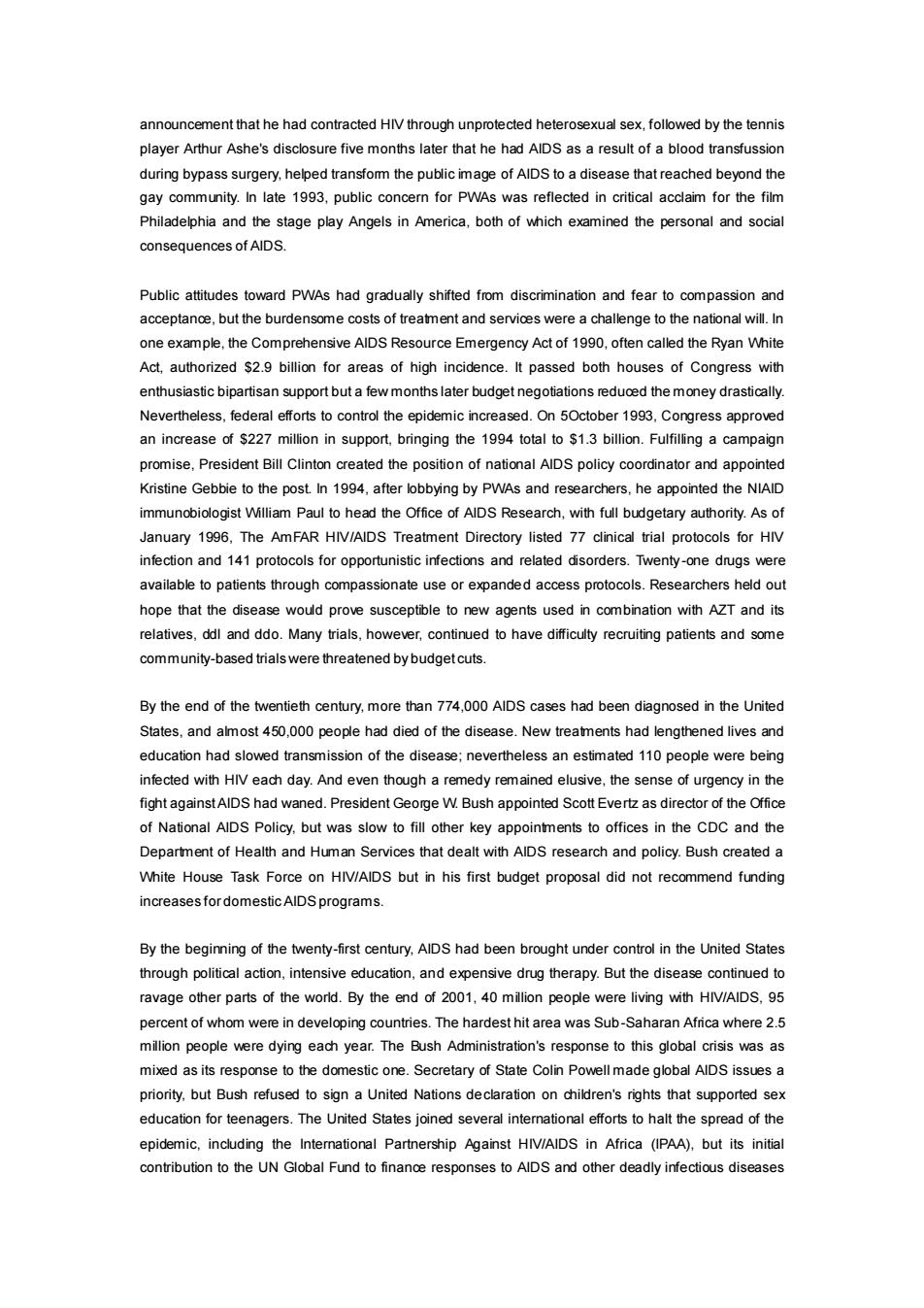
announcement that he had contracted HIV through unprotected heterosexual sex.followed by the tennis during bypass surgery, ethat reached beyondh gay community.In late 1993,public concern for PWAs was reflected in critical acclaim for the film Philadelphia and the stage play Angels in America,both of which examined the personal and social consequences of AlDS. Public attitudes toward PWAs had gradually shited from discrminaion ad fear to compassion and acceptanoe,but the burdensome costs of treatment and services were a challenge to the national will.In one example,the Comprehensive AlDS Resource Emergency Act of 1990,often called the Ryan White Act authorized s2 9 billion for areas of high incidence.it passed both houses of Conaress with enthusiastic bipartisan support but a few months later budget negotiations reduced the money drastically dOn 5Octobe Congress approved an increase of $227 million in support,bringing the 1994 total to $1.3 billion.Fuliing a campaig promise,President Bill Clinton created the position of national AlDS policy coordinator and appointed Kristine Gebbie to the post.In 1994.after lobbying by PWAs and researchers,he appointed the NIAID immunobiologist William Paul to head the Office of AlDS Research,with full budgetary authority.As of January 1996.The AmFAR HNV/AIDS Treatment Directory listed 77 dinical trial intecionand141potoce oppor nty-one dru available to patients through compassionate use or expanded access protocols.Researchers held ou hope that the disease woud prove susceptible to new aoents used in combination with AZT and its relatives,ddl and ddo.Many trials,however,continued to have difficulty recruiting patients and some ommuniy-based trialswere hreatened bybudgetcuts. By the end of the twentieth century.more than774.000 had been diagnosed nthe United States,and amost 450.000 people had died of the disease.New treatments had lengthened lives and education had slowed transmission of the disease:nevertheless an estimated 110 peode were being infected with HIV each day.And even though a remedy remained elusive.the sense of urgency in the eW.Bush appoin Polcy but wshr inCC ted Scott Eve rtz as direct Department of Health and Human Services that dealt with AlDS research and policy.Bush created a White House Task Force on HIV/AIDS but in his first budget proposal did not recommend funding increases for domestic AlDS programs. By the begming of the twenty-first tury.AIDS had been brought under in the United States hrough political action,intensive education,and expensive drug therapy.But the disease continued t ravage other parts of the world.By the end of 2001.40 million people were living with HIV/AIDS.95 percent of whom were in developing countries.The hardest hit area was Sub-Saharan Africa where 2.5 million people were dving each vear.The Bush Administration's response to this global crisis was as mixed as itse the mestic one.Secretary of State Colin Powell madeg al AIDS issues a priority.but Bush refused tosign a United Nations children'sights that supported se education for teenagers.The United States joined several international efforts to halt the spread of the epidemic.including the Intemational Partnership Against HIV/AIDS in Africa (IPAA).but its initial contribution to the UN Global Fund to finance responses to AlDS and other deadly infectious diseases
announcement that he had contracted HIV through unprotected heterosexual sex, followed by the tennis player Arthur Ashe's disclosure five months later that he had AIDS as a result of a blood transfussion during bypass surgery, helped transform the public image of AIDS to a disease that reached beyond the gay community. In late 1993, public concern for PWAs was reflected in critical acclaim for the film Philadelphia and the stage play Angels in America, both of which examined the personal and social consequences of AIDS. Public attitudes toward PWAs had gradually shifted from discrimination and fear to compassion and acceptance, but the burdensome costs of treatment and services were a challenge to the national will. In one example, the Comprehensive AIDS Resource Emergency Act of 1990, often called the Ryan White Act, authorized $2.9 billion for areas of high incidence. It passed both houses of Congress with enthusiastic bipartisan support but a few months later budget negotiations reduced the money drastically. Nevertheless, federal efforts to control the epidemic increased. On 5October 1993, Congress approved an increase of $227 million in support, bringing the 1994 total to $1.3 billion. Fulfilling a campaign promise, President Bill Clinton created the position of national AIDS policy coordinator and appointed Kristine Gebbie to the post. In 1994, after lobbying by PWAs and researchers, he appointed the NIAID immunobiologist William Paul to head the Office of AIDS Research, with full budgetary authority. As of January 1996, The AmFAR HIV/AIDS Treatment Directory listed 77 clinical trial protocols for HIV infection and 141 protocols for opportunistic infections and related disorders. Twenty-one drugs were available to patients through compassionate use or expanded access protocols. Researchers held out hope that the disease would prove susceptible to new agents used in combination with AZT and its relatives, ddl and ddo. Many trials, however, continued to have difficulty recruiting patients and some community-based trials were threatened by budget cuts. By the end of the twentieth century, more than 774,000 AIDS cases had been diagnosed in the United States, and almost 450,000 people had died of the disease. New treatments had lengthened lives and education had slowed transmission of the disease; nevertheless an estimated 110 people were being infected with HIV each day. And even though a remedy remained elusive, the sense of urgency in the fight against AIDS had waned. President George W. Bush appointed Scott Evertz as director of the Office of National AIDS Policy, but was slow to fill other key appointments to offices in the CDC and the Department of Health and Human Services that dealt with AIDS research and policy. Bush created a White House Task Force on HIV/AIDS but in his first budget proposal did not recommend funding increases for domestic AIDS programs. By the beginning of the twenty-first century, AIDS had been brought under control in the United States through political action, intensive education, and expensive drug therapy. But the disease continued to ravage other parts of the world. By the end of 2001, 40 million people were living with HIV/AIDS, 95 percent of whom were in developing countries. The hardest hit area was Sub-Saharan Africa where 2.5 million people were dying each year. The Bush Administration's response to this global crisis was as mixed as its response to the domestic one. Secretary of State Colin Powell made global AIDS issues a priority, but Bush refused to sign a United Nations declaration on children's rights that supported sex education for teenagers. The United States joined several international efforts to halt the spread of the epidemic, including the International Partnership Against HIV/AIDS in Africa (IPAA), but its initial contribution to the UN Global Fund to finance responses to AIDS and other deadly infectious diseases